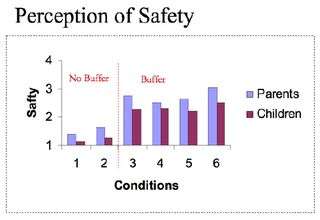Why don't kids walk to school anymore?

Maybe when we were their age, we walked five miles to school, rain or shine. So why don't most children today walk or bike to school?
It's not necessarily because they're spoiled, lazy or over scheduled. According to a University of Michigan researcher, concerns about safety are the main reason that less than 13 percent of U.S. children walked or biked to school in 2004, compared to more than 50 percent who did so in 1969.
"These concerns are strongly linked to the kind of physical environment children navigate between home and school," said Byoung-Suk Kweon, an environmental and landscape architecture researcher at the U-M Institute for Social Research (ISR).
"The greener the route, the more likely it is that children will walk and bike."
Using Geographic Information System (GIS) data combined with a survey of 186 parents of 5th through 8th grade students, Kweon found that parents were most concerned about the speed and volume of traffic students would encounter en route to school; the possibility of crime; and the weather.
"In Texas, where we lived when I conducted this study, our sons did not walk to school because we lived too far away," said Kweon, who is also affiliated with the U-M School of Natural Resources and Environment. In general, she found, children who walk to school usually live less than three-quarters of a mile away.
"In Ann Arbor, they do walk to school. We have a 27 degree rule. If it's colder than that, we drive them; if it's warmer than that, they walk."
In her study, Kweon found that children use sidewalks, not bike lanes, when they ride to school. "Parents may be concerned about the safety of bike lanes, and they may be telling their children to ride on the sidewalk because it's safer," she said. "We may need to re-think how to place bike lanes in school walk zones."
To learn more about how the physical environment influences parents' perceptions of safety and their willingness to allow their children walk or bike to school, Kweon and colleagues conducted a series of laboratory-based simulation studies, testing six different pedestrian environments.
"It's very important for parents that there be a separation or buffer between traffic and the sidewalk," she said. "They are much more willing to let their children walk when this buffer is at least eight feet wide, and when there are also trees in this area." Trees not only provide shade, but also serve as a sort of vertical barrier between sidewalk and street.
Although improving the physical environment reduces parents' concerns for their children's safety, Kweon found that the social environment—especially the likelihood of crime—strongly affects parental perceptions of safety as well. Kweon hopes to conduct a related study in Detroit to examine how the intersection of social and physical factors influences the likelihood that children will walk to school.
By identifying environmental elements conducive to walking and biking to school, Kweon hopes her research may help improve children's physical health and reduce the incidence of childhood obesity, especially prevalent among minority children.
"Walking or biking to school helps children develop an early habit of engaging in physical activity, and that can lead to a healthier and more active and healthier population," she said.
Source: University of Michigan





















